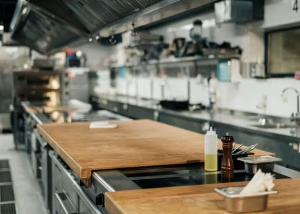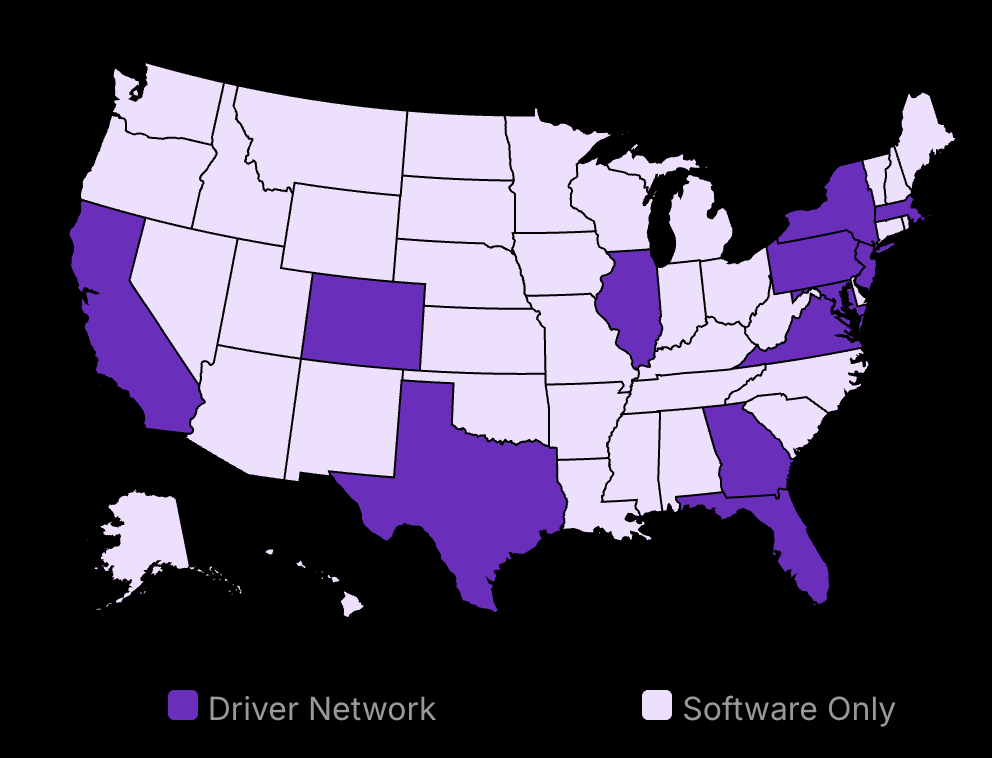Restaurant kitchen layouts are hard to get right. A bad commercial kitchen layout costs you money—every single day.
But numbers only tell part of the story. Here’s what most restaurant owners get wrong: They think kitchen space design is about fitting cooking equipment into a room. It’s not. It’s about creating a commercial kitchen where your staff can work at their best. Where food moves smoothly from food preparation to plate. Where every cooking station is positioned to save time instead of wasting it.
You’re about to learn the six types of restaurant kitchen layouts that work. Not just in theory, but in real, busy restaurants serving hundreds of customers daily. You’ll see why some layouts fail while others thrive. Most importantly, you’ll learn how to choose the right design for your specific needs.
This isn’t just about making your back of house look good. It’s about making it work well. Because in the restaurant business, efficiency equals profit. And profit is what keeps your doors open.
Let’s look at what makes a commercial kitchen truly efficient—from food prep to workflow to food preparation areas and equipment placement. No fancy concepts. Just real solutions that work in real kitchens.

27% higher customer satisfaction
Professional delivery features:
- Real-time GPS tracking
- Automated ETA updates
- Delivery confirmation photos
- 27% higher delivery satisfaction
What are the Types of Restaurant Kitchens?
Different kitchen types support cooking needs.
Design impacts efficiency, workflow, and customer interaction.
Strategic choices lead to better staff well-being and customer service.
Understanding different restaurant kitchens helps boost workflow and staff happiness. Let’s see which types work best for various needs. If you want more insights on optimizing kitchen designs, check out these detailed tips on improving efficiency in a restaurant setup. With a well-planned kitchen layout, you can streamline operations and enhance the overall dining experience. For comprehensive guidance, visit our article on Commercial Kitchen Layouts.
1. Island Kitchen
Island kitchens feature a central prep space. It often involves cooking or preparation activities right in the center. Islands promote open communication among staff, foster teamwork, and enable flexible workflow management. This style is best for large spaces and varied menus.
An island kitchen works well in high-end restaurants where staff communication leads to quality dishes. It supports interactive cooking or chef’s tables where customers enjoy watching meals being prepared.
Victor Cardamone noted that if your kitchen is square, an island layout is perfect. This setup allows chefs to seamlessly manage complex dishes without crisscrossing other staff members.
2. Galley Kitchen
Galley kitchens maximize space with parallel counters. This design is efficient in small areas, like food trucks or coffee shops. They are cost-effective and maintain quick operations. Galley kitchens maintain a straightforward layout, allowing minimal movement and helping staff focus on their roles.
This style is great for startups due to its low cost and effectiveness in small spaces. It simplifies the flow and cuts down preparation time significantly.
Many experts highlight this kitchen style for its optimal space efficiency. Particularly in places with tight budgets, this design proves functional without compromising quality.
3. Open Kitchen
Open kitchens entice customers by revealing kitchen operations. They break down the wall between kitchen staff and diners, letting guests see the cooking process. This encourages a lively dining atmosphere and enhances customer experience. Typically found in casual dining or high-end restaurants, this setup bridges the connection between guests and culinary staff.
The transparency builds trust and makes dining more exciting. However, it requires strict hygiene and organization. Critics argue it’s demanding on staff, but proponents believe it enriches the dining experience, making it memorable.
4. Zone Style Kitchen
Zone-style divides the kitchen into specific areas such as prep, cooking, and plating. It’s common in larger operations with extensive menus like hotels or catering services. This setup enables multitasking, as each section focuses on different tasks without interference, promoting teamwork.
Zone kitchens are efficient and minimize traffic. Yet, they require adept staff management and precise communication. Each area becomes a mini-kitchen handling its dedicated recipes, fostering specialization among the chefs. Critics claim configurational adjustments might seem costly, yet it’s efficient for high-volume gourmet service.
5. Assembly Line Layout or Fast Food Restaurant Kitchen
Designed for rapid production, assembly line kitchens are ideal in fast food and fast-casual settings. This format is perfect for high-volume, repeatable meal preparation. It requires efficient station setups to ensure each part of the meal is prepared and transferred smoothly.
Making each dish piece by piece, this style minimizes menu adaptation and requires less skill. However, monotony can decrease staff motivation, demanding constant attention to morale.
6. Ergonomic Kitchen
Ergonomic designs prioritize minimizing cook staff strain, reducing injuries, and boosting long-term well-being. This style focuses immensely on comfort, positioning equipment at suitable heights, and optimizing reach. Recognized for supporting staff health, it’s favored by restaurants valuing worker longevity.
By mitigating fatigue and injury, this setup can curtail absenteeism and turnover. While it may involve investment in specialized equipment, it pays off with happier and healthier teams.
Commercial Kitchen Layouts: Choosing the Right Type
Understand key factors that affect kitchen layout decisions.
Align kitchen design with your business model.
Optimize space for maximum efficiency.
Factors Influencing Layout Choice
Space Availability and Shape
The size and shape of your kitchen play a pivotal role in determining the best layout. For long, narrow spaces, an assembly line layout works well, linearly streamlining the food production process. Square spaces, on the other hand, are ideal for island kitchen layouts, facilitating central operations and optimal counter space usage. These layouts are especially effective in hotel restaurants or event space kitchens where workflow efficiency and staff interaction are essential. Two primary layout considerations guide this decision.
Space Allocation in Restaurants: According to Viqal, 40% of the total area is often allocated to the kitchen and back-of-house operations, while 60% is designated for customer-facing areas.
Adhering to the fundamental workflow principles of receiving, food storage, preparation, cooking, serving, and cleaning minimizes cross-traffic and contamination risks. Designing a kitchen that aligns with its physical dimensions enhances not just functionality but also operational success.
Type of Cuisine and Services Offered
The type of cuisine and services you offer directly impact your kitchen layout. Restaurants with complex menus benefit from separate stations for preparation, such as a salad station, washing station, and food warm areas. A zone-style kitchen excels in these settings, minimizing overlap and confusion. Simpler menus, however, thrive in open kitchen layouts, where visibility and swift preparation are priorities.
Tailoring the equipment and layout to match the menu ensures smooth operations and maintains food quality. For instance, if your menu includes intricate dishes or frequent use of spice blends, incorporating ample cooking tools and prep areas is essential. As noted by industry experts, a well-designed kitchen streamlines workflows, ensuring consistent and timely service tailored to the menu’s demands.
Matching Layouts to Business Models
Quick Service vs. Full Service
Different restaurant types have unique demands. Quick-service restaurants (QSR) need layouts that maximize speed. Assembly line kitchens fit QSR well, supporting high-volume, fast-paced preparation. This layout minimizes skill requirements and ensures the food reaches customers promptly, an expectation in fast-paced settings.
Full-service restaurants (FSR) require more comprehensive setups. An island or zone-style layout suits FSRs, as these support complex dishes and personalized service. Full-service kitchens demand precise coordination and communication among staff to ensure quality and meet higher service expectations.
Understanding these dynamics is vital. Quick service thrives on speed and efficiency, while full service focuses on quality and detail. Tailoring your kitchen design to fit these models influences overall customer satisfaction and operational success.
Importance of Customer Interaction
Some restaurants leverage their kitchen as part of the dining experience. Open kitchen layouts allow customers to witness the food production process, fostering engagement and trust. However, this requires a highly organized space with clear zoning layouts, such as designated washing stations or salad stations, and well-trained staff for seamless operations.
In contrast, hidden kitchens in FSRs focus solely on perfecting dishes away from distractions. Depending on your business goals, the visibility of your kitchen can significantly impact customer perception. While open layouts enhance transparency and trust, they demand rigorous cleanliness and punctual service.
Modular Design and Smart Equipment: Emerging Trends
Adapting to modern trends is crucial for staying competitive. Modular kitchen designs are increasingly popular, offering flexibility to adjust components as business needs evolve. This is especially advantageous in dynamic environments like event space kitchens, where operations frequently change.
Smart kitchen equipment is another game-changer. These tools improve sustainability and efficiency, streamlining the food production process while reducing energy consumption. Such advancements align with eco-conscious practices and help cut costs in the long term. By integrating modular and smart solutions, businesses can future-proof their kitchens to keep pace with evolving demands.
Benefits of Restaurant Kitchen Workflow Optimization
Boosts kitchen speed and customer satisfaction.
Cuts down on wasted resources and raises profits.
Streamlines staff roles for better teamwork.
Enhanced Efficiency
Streamlining the workflow in a commercial kitchen ensures faster prep and service times, which is especially crucial for catering kitchens and sandwich shops. An efficient layout, such as a ring layout or popular commercial kitchen layouts with separate zones for central preparation, ensures that all the stations function seamlessly. When the dining area receives meals promptly, it boosts customer satisfaction, a critical aspect of any food business. Space can hinder workflow, so proper utilization—like incorporating storage units—is vital for maintaining flow and organization.
Integrating modern equipment like gas range oven combinations and commercial fryers can reduce wait times and enhance productivity. Tools such as Kitchen Display Systems (KDS) facilitate precise communication between the same kitchen’s preparation and service area, reducing errors and speeding up the delivery of high-quality meals. Strategic design, like using a glass partition for visibility and safety, also contributes to smooth operations.
Impact of Wait Times on Customer Satisfaction and Revenue
Customer Perception: The average customer overestimates how long they had to wait for service by 40%.
Revenue Impact: A study published in ScienceDirect found that eliminating waits could increase total revenue by nearly 15%, as shorter wait times lead to higher customer satisfaction and repeat visits.
Satisfaction: Additionally, the American Customer Satisfaction Index (ACSI) highlights that customers who wait longer than expected are 18% less satisfied with their overall experience.
Cost Reduction
Optimizing workflows within catering kitchens and designing a commercial kitchen to support limited menus reduces waste and unnecessary steps, saving time and resources. For example, investing in commercial fryers tailored to menu needs or gas range oven combinations suited for ring layouts ensures energy efficiency while avoiding redundant purchases. Proper zoning, including separate zones for prep and storage, enhances organization and eliminates idle tasks.
These measures ensure efficient use of inventory, reducing costs associated with overstocking or spoilage, which is especially relevant for food businesses offering high-quality meals. Such efficiency ensures more significant profit margins without compromising quality.
Improved Staff Coordination
With optimized workflows, staff members understand their roles clearly, leading to better teamwork. When each employee knows their task and how it fits into the larger process, the kitchen operates as a cohesive unit. This not only improves service efficiency but also enhances morale as employees feel part of an effective team. Books like Leading in Uncertainty: Team Dynamics in Hospitality explore managing effective teams under pressure. The insights draw on leadership theories that propose fostering a culture of open communication and responsibility sharing among kitchen staff.
One potential challenge includes the initial resistance from staff used to traditional workflows. However, fostering an environment where roles and responsibilities are well communicated can lead to seamless operations. It’s crucial to involve staff in the redesign process, ensuring they understand changes and see the benefits firsthand.
Increased Safety
Optimized kitchen layouts and workflows contribute to reduced risk of accidents. Clear pathways reduce slip and fall hazards, while properly organized stations minimize cross-contamination risks. Books like Restaurant OSHA Safety and Security: Review and Implementation Tool Kit offer practical guidelines on creating safe work environments. Streamlined workflows emphasize keeping tools and ingredients in designated areas, ensuring minimal movement and reducing the chance of accidents.
Implementing safety protocols and ergonomics in kitchen design not only keeps employees safe but also minimizes liability issues for the restaurant. Critics argue that rigorous safety guidelines can be restrictive. However, when implemented thoughtfully, these measures can lead to a comfortable and efficient working environment.
Data-Driven Decision-Making
Leveraging data analytics in kitchen workflows empowers restaurants to make informed decisions, optimizing inventory levels while predicting demand accurately. Using technology that tracks sales trends and customer preferences provides invaluable insights. Books such as Big Data in Small Places: Analytics for Independent Restaurants provide examples of how data use can drive better results.
While some critics argue data can lead to impersonal service, the strategic application allows for personalizing services based on customer history and preferences. Advanced insights support menu optimization, aligning menu items with buyers’ needs while reducing inventory challenges.
Sustainable Restaurant Kitchen Layout Designs
Energy-efficient design leads to significant cost savings.
Eco-friendly materials reduce environmental impact.
Long-term sustainability enhances brand reputation.
Energy Efficient Equipment
Restaurants can greatly reduce energy costs by using energy-saving appliances. Commercial kitchens consume a lot of electricity. Equipment like ovens, refrigerators, and dishwashers are always in use. Energy-efficient models can cut these costs. Appliances labeled with ENERGY STAR are also suitable options. They meet certain efficiency standards, leading to energy savings without sacrificing performance.
Energy Savings: Energy-efficient dishwashers can save up to 30% in energy costs due to improved designs that use less water and electricity.
ENERGY STAR Refrigerators: ENERGY STAR-certified refrigerators are noted for being approximately 15% more efficient than non-certified models, contributing to overall savings.
When investing in these, consider initial costs versus long-term savings. Studies suggest that although initial costs might be higher, energy savings often pay off within a few years. Furthermore, some regions offer rebates or incentives for installing such equipment. For those looking to dive deeper, “The Energy-Smart Kitchen,” a renowned book, provides greater insights into choosing efficient kitchen tech.
While some may argue about the high upfront cost, the benefits far outweigh these concerns over time. Efficiency not only impacts the bottom line but also reduces the carbon footprint. This contributes to a more sustainable and responsible restaurant operation.
Sustainable Materials and Practices
Using sustainable materials in kitchen design aids long-term sustainability. Materials like bamboo, recycled steel, and reclaimed wood are both durable and eco-friendly. Bamboo, for example, grows quickly and does not require replanting after harvest, making it an excellent renewable resource.
Incorporating practices like recycling and composting can further enhance sustainability. Implementing a comprehensive waste management system can reduce landfill waste significantly. This not only benefits the environment but also cuts waste disposal costs.
Books such as “Cradle to Cradle” explore these ideas in depth, offering strategies for implementing sustainable systems. Consider also exploring green certifications like the Green Restaurant Association. They provide guidelines and benchmarks for sustainability in the food service sector.
Opponents may argue that such practices might complicate operations or add extra duties. However, with proper planning and staff training, these considerations can be integrated seamlessly.
Water Conservation Measures
Another aspect of sustainable kitchen design is water conservation. Restaurants use significant amounts of water daily. Installing low-flow faucets and efficient dishwashers can cut water use. The US Environmental Protection Agency offers tools and resources to estimate potential savings from different conservation measures.
Some kitchens are even implementing rainwater harvesting systems. This innovation allows the reuse of water for non-potable purposes, like landscaping or cleaning. While initial setup costs might be notable, the long-term savings and environmental benefits are substantial.
Read “The Big Thirst” for more on water-saving technologies and techniques. It covers effective conservation strategies suitable for commercial settings. While conservation might seem cumbersome, its long-term benefits, such as reduced water bills and enhanced environmental responsibility, are undeniable.
Eco-Friendly Ventilation Systems
Efficient ventilation is vital to any kitchen, affecting air quality and energy use. Eco-friendly hoods with energy recovery systems have gained popularity. These systems capture and reuse heat, offsetting additional energy needs. This not only reduces energy costs but maintains better kitchen air conditions.
For detailed technical insights, “Ventilation for Control of the Work Environment” is an excellent resource. It dives deep into different systems and their operational effectiveness. Critics might suggest that vents with such capabilities have high maintenance needs. However, the improved air quality and reduced energy consumption make them worthwhile investments.
Green Certification and Compliance
Pursuing green certifications can bolster a restaurant’s sustainable image. Certifications like LEED (Leadership in Energy and Environmental Design) or the aforementioned Green Restaurant Association show commitment to eco-friendly practices.
These certifications require adherence to specific criteria, from energy use to waste management. Meeting these standards could increase upfront costs, but the long-term benefits include increased customer trust and potentially higher patronage. Studies note that consumers are increasingly valuing environmental responsibility in businesses they choose to support.
“The Sustainable Restaurant” is a comprehensive guide on this topic, providing strategies to achieve and maintain these certifications. Adopting eco-friendly designs can serve dual purposes—operational efficiency and enhanced brand value in a competitive market.
Kitchen Equipment Selection for Efficiency
Focus on must-have equipment over nice-to-have.
Align tools with menu needs for better efficiency.
Engage chefs in the selection process.
Prioritizing Essential Equipment
Choosing the right kitchen equipment impacts restaurant efficiency significantly. Start by listing items by essentiality. This helps chefs and owners decide on investments based on need rather than desire. High-demand tools are critical. Unnecessary items clutter the workspace and waste money. Decisions should be made by both front-line staff, like chefs, and those managing finances.
Consider the longevity and quality of equipment. While high-quality equipment might have a hefty price tag upfront, it saves money in the long run. Quality tools incur lower maintenance costs and typically last longer. Exploring options through leasing can ease the financial burden without compromising on quality, ensuring essential equipment is always at the ready.
Adapting Equipment to Menu Needs
Restaurant menus guide equipment choices. Equipment versatility is crucial for managing diverse menus efficiently. For instance, a combi oven, which performs multiple cooking functions, is more versatile than a standalone convection oven. It reduces space, and energy consumption, and enhances the ability to execute various dishes.
Select tools that match the planned menu. A seafood-centric eatery may prioritize grilling and frying appliances over extensive baking gear. Each item should align with popular dishes to avoid unnecessary expenditure. This approach not only boosts efficiency but also enhances the quality of dishes prepared, adapting tools to menu requirements.
Considering Energy Efficiency
The type of kitchen appliances impacts overall energy usage. Energy-efficient tools provide sustainability advantages and operational cost savings. Replacing older high-energy equipment with new energy-efficient models can cut energy consumption. This not only saves on utility bills but also provides a return on investment in less than two years. Implementing demand-controlled kitchen ventilation systems can halve ventilation energy use. These steps significantly impact long-term financial health and environmental responsibility.
Harnessing Chef Expertise
Engaging chefs in equipment selection is crucial. They understand the kitchen’s demands better than anyone else. Their input ensures that purchases meet practical needs. Chefs often know what items are essential and which novelties can be skipped. This involvement streamlines the selection process and helps avoid unnecessary acquisitions.
Incorporating chef feedback prevents future bottlenecks. It contributes to operational efficiency by understanding the day-to-day challenges they face. For chefs, the right equipment can be the difference between a smooth service and a chaotic kitchen.
Exploring Financing Options
The cost of kitchen equipment significantly impacts restaurant budgets. Prospective owners should weigh ownership against leasing. Leasing offers the benefit of lower initial costs while providing access to high-quality appliances. This can be a practical solution for start-ups aiming to conserve cash flow.
Leasing options offer flexibility in upgrades and replacements. This is an advantage in a fast-paced industry where technology evolves rapidly. Consider the longevity and potential return on investments in buying outright versus lease options, allowing for strategic, long-term planning and smooth adjustments with industry changes.
How to Optimize Restaurant Kitchen Workflow
Streamline processes for improved efficiency.
Reduce food prep time and boost productivity.
Enhance staff performance with clear strategies.
Step #1: Assess Current Workflow
Start by looking at your current workflow. Do a thorough review of daily operations. The aim is to spot problem areas that slow things down. Look for bottlenecks – places where work backs up – and identify any inefficiencies that waste time or resources.
Ask staff for their input. They are the ones navigating these workflows every day. Their feedback can reveal overlooked problems. Conduct brief interviews or surveys. Questions could include which tasks seem to take too long, or where movement is constrained.
Consider using workflow mapping tools. They allow you to visualize the flow of operations. This can highlight inefficiencies more clearly. Look for areas where time and labor could be better used. Once you have a detailed analysis, you can start planning changes. By engaging with your team, you’ll develop a comprehensive understanding of the current state of your kitchen’s workflow.
Visualization Tools and Staff Feedback
Using tools like flowcharts can help in understanding workflow visually. They make it easier to pinpoint areas needing improvement. Software options are available that let you simulate different layouts and processes. Staff feedback is key. Hold feedback sessions to discuss observations and suggestions. Regularly update team members on any workflow changes and involve them in decision-making. This builds ownership and leads to smoother transitions.
Step #2: Implement Changes
Once you’ve assessed your workflow, it’s time to make improvements. Start by introducing time-saving techniques. For instance, batch prep work such as cutting veggies in advance can save hours across shifts. Look for kitchen tasks that can be done more efficiently through minor adjustments.
Consider the kitchen layout too. Sometimes, simply rearranging where equipment is placed can lead to major efficiency gains. If food has to travel too far from one station to another, it causes delays. A strategic layout ensures minimal movement and easy access to necessary tools and ingredients.
Think about ergonomics as well. Kitchen staff spend long hours on their feet, so positioning stations effectively reduces unnecessary stress and fatigue. It might be worthwhile to consult with a kitchen design expert. They can provide insights into creating a layout that supports efficient workflow while keeping costs down.
Making Practical Adjustments
Changes don’t have to be massive. Even small tweaks can make a difference. Adjust station heights for comfort and efficiency. Ensure that frequent-use items are at arm’s reach and that pathways are clear. You could also test different arrangements on a trial basis to determine what works best for your team.
3 Strategies for Maximizing Efficiency
Cross-training Staff
Cross-training means teaching employees various roles. This flexibility ensures that if one person is missing, others can cover their duties. Everyone should have a basic understanding of different tasks. This approach not only fills gaps but also boosts team cooperation and morale.
Streamlining Supply Chain
Efficient supply chain management is a game-changer. Implement systems that automate inventory and procurement, like SCM systems which significantly improve efficiency. This helps monitor stock levels and reduce waste. Establishing strong relationships with suppliers can secure better pricing and reliable delivery. It cuts the risk of running out of ingredients or overstocking.
Utilizing Technology
Technology assists in numerous ways. Invest in modern systems to automate and streamline tasks. A useful stat here: Many restaurant operators are doing just this to improve productivity. Tools like AI assistants can drastically cut prep times. These technologies minimize waste and enhance accountability. Staff can focus on high-skill tasks rather than repetitive ones.
Incorporate digital checklists or kitchen display systems (KDS). These reduce order processing errors and improve communication between the front and back of the house.
In summary, by diligently assessing current workflows and strategically implementing changes, restaurants can greatly enhance their kitchen operations for higher efficiency and productivity.
What are the 4 Major Systems in a Commercial Kitchen?
Cooking, refrigeration, storage, and sanitation.
Essential for day-to-day operation and safety.
Impacts efficiency and organization.
1. The Cooking System
The cooking system is the heart of every kitchen, where food transforms from raw ingredients to dishes ready to be served. It involves a range of equipment including ovens, stoves, fryers, and grills. Their setup greatly affects the workflow and efficiency. Equipment placement should reduce unnecessary movement to speed up service. Digital tools, such as kitchen display systems (KDS), enhance coordination and messaging between the front and back of the house. This reduces errors and speeds up ticket times.
Experts in the field suggest that an optimized cooking area is critical not just for efficiency but also for maintaining food quality. A well-planned cooking system saves time and increases the kitchen’s output, especially during peak hours. A top resource for exploring optimal equipment configurations is the book “The Food Service Professional Guide”. This book provides practical layouts and configurations fitted for various types of dining establishments.
However, some argue against heavy technology reliance on the cooking system. They believe that while digital systems can help, excessive reliance may lead to disruptions in case of technical failures. Understanding both benefits and drawbacks can guide effective integration.
2. The Refrigeration System
Refrigeration keeps food items safe to consume and fresh by maintaining them at proper temperatures. In a commercial setting, this system includes walk-in refrigerators, freezers, and regular reach-in units. Its placement within the kitchen is strategic: it must be easy to access but not disrupt the flow of work.
Incorrect refrigeration practices pose significant threats to food safety. The University of Minnesota highlights that overstocking shelves can lead to temperature inconsistencies, compromising food safety. Proper structuring and maintenance of refrigeration units ensure optimal efficiency. Books such as “The Restaurant Manager’s Handbook” dive deeper into spatial and functional considerations for refrigeration systems.
Despite keeping food fresh, refrigeration demands significant energy resources and space. To tackle this, innovations in energy-efficient refrigeration are being explored. Balancing the benefits of freshness with energy use and costs remains a key challenge.
3. The Storage System
An effective storage system supports the organization and reduces waste. It includes shelving, cabinets, and inventory tracking systems crucial for optimal kitchen functionality. By utilizing space smartly, storage can minimize clutter, reduce retrieval times, and streamline kitchen operations.
Administrators face challenges in maximizing limited space and maintaining stock levels. Open shelving has gained popularity for its easy access but demands strict organization to prevent clutter. Storage designs influence how quickly and easily staff can access and refit items. Experts often reference “Garvey’s Modern Handbook of Restaurant Management” for insights on modern inventory and storage solutions.
One potential drawback is the upfront cost of storage solutions with robust inventory tracking. Nonetheless, they usually pay off by preventing over-purchasing and reducing spoilage, ultimately cutting costs in the long run.
4. The Sanitation System
Sanitation is the invisible backbone of any kitchen. It encompasses the facilities and routines in place to maintain cleanliness and food safety. This involves dishwashers, sinks, cleaning tools, and protocols for hand hygiene. Consistent and thorough cleaning protocols ensure food safety and compliance with health regulations.
The importance of sanitation cannot be overstated. While the University of Minnesota stresses sanitation’s integral role in food safety, some outlets argue for more automated cleaning systems to cut down on labor costs. However, improper automation can sometimes lead to shortcuts that elevate health risks. Therefore, it is crucial to ensure that technology complements rather than replaces effective practices.
In summary, understanding these systems’ roles can notably optimize and refine restaurant kitchen operations. Delving into specific texts, a great one is “Restaurant Success By The Numbers,” which closely examines each system’s impact on performance metrics. Efficient integration of each component is a foundational element of restaurant operations.
Which Kitchen Design is Most Efficient?
Understand key kitchen layouts and their benefits.
Identify factors influencing kitchen efficiency.
Key Kitchen Layouts and Their Benefits
Restaurant kitchens come with various layout options. These influence meal prep and service speed. The right layout can boost staff performance without causing burnout. Common designs include work triangles, zone planning, and space-specific solutions.
Work Triangle Concept: The work triangle focuses on placing the fridge, sink, and stove strategically. This setup allows staff to move efficiently, reducing fatigue and time lost in transit. An optimal triangle ranges from 13 to 26 feet. It’s a practical choice for many traditional kitchens.
Example: In a high-paced restaurant that serves dozens of meals per hour, the work triangle can cut down the extra steps staff might take. Having ingredients, cooking stations, and sinks in close proximity minimizes bottlenecks.
Zone Planning: This divides a kitchen into functional areas like preparation, cooking, and cleaning. Each zone is optimized for specific tasks, which helps manage resources effectively.
Example: In a zone-planned kitchen, staff can focus on their specialized tasks without overlapping with others. This minimizes confusion and maximizes output, especially during peak hours.
Space-Specific Solutions: Depending on the kitchen’s size, unique adjustments must be made. Galley kitchens, for example, are ideal for small spaces like food trucks. They use parallel counters to maximize limited room. Larger restaurants might opt for open layouts, allowing more interaction and flexibility.
Factors Influencing Kitchen Efficiency
Efficiency goes beyond layout—it includes lighting, team management, and tools. Let’s break these down:
Lighting: Proper lighting is essential. It affects visibility and safety. Energy-efficient LEDs provide powerful lighting while saving on costs. They also last longer than traditional bulbs.
Team Management: An efficient kitchen needs well-trained staff. Proper scheduling and role clarity improve efficiency. Staff must know their roles and work cohesively, even replacing each other temporarily if needed.
Technology Integration: Modern kitchens benefit from tech. Automated systems and scheduling software streamline operations, reducing wait times and errors. For instance, digital order screens eliminate the manual handling of paper tickets, speeding up communication.
Expert input: A well-designed kitchen impacts workflow, minimizes bottlenecks and enhances overall efficiency.
Understanding these designs and factors, professionals can craft a kitchen environment that meets their needs, merging functionality with style. Balancing these elements makes a restaurant more productive, safe, and enjoyable for both staff and customers.
Moving Your Kitchen Design Forward
A well-planned kitchen design shapes every part of a restaurant’s success. From the speed of service to staff well-being and profit margins, each layout choice creates lasting effects on daily operations. Understanding the types of restaurant kitchens and how they support your workflow is essential to building a successful restaurant.
The best kitchen design balances your specific needs. Look at your menu, service style, and team size. Consider your space limits and budget. These factors will point you to the right layout—whether it’s an assembly line kitchen layout for fast-paced production or a fine dining kitchen setup designed for precision and artistry. In smaller spaces, the galley layout makes the most of narrow areas while maintaining efficient food preparation areas.
Keep three key points in mind as you plan your kitchen:
Put staff comfort first through smart ergonomic choices.
Choose cooking equipment that serves multiple purposes.
Design spaces that can change as your business grows.
Don’t overlook the importance of the dining room when designing your kitchen; the flow between the back-of-house and front-of-house must work seamlessly. Start small. Pick one area of your kitchen to improve first. Test changes with your team and adjust based on their feedback. Remember that kitchen design is an ongoing process—you’ll need to update as your business changes.
The most successful kitchens combine practical layouts, efficient workflow, and staff-focused design. Your next step is to assess your current setup and identify one change you can make this week to improve your kitchen’s performance.


























